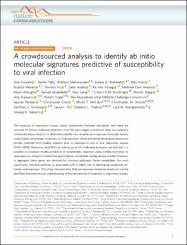| dc.contributor.author | Fourati, Slim | |
| dc.contributor.author | Talla, Aarthi | |
| dc.contributor.author | Mahmoudian, Mehrad | |
| dc.contributor.author | Burkhart, Joshua G. | |
| dc.contributor.author | Klén, Riku | |
| dc.contributor.author | Henao, Ricardo | |
| dc.contributor.author | Yu, Thomas | |
| dc.contributor.author | Aydın, Zafer | |
| dc.contributor.author | Yeung, Ka Yee | |
| dc.contributor.author | Ahsen, Mehmet Eren | |
| dc.contributor.author | Almugbel, Reem | |
| dc.contributor.author | Jahandideh, Samad | |
| dc.contributor.author | Liang, Xiao | |
| dc.contributor.author | Nordling, Torbjörn E.M. | |
| dc.contributor.author | Shiga, Motoki | |
| dc.contributor.author | Stanescu, Ana | |
| dc.contributor.author | Vogel, Robert | |
| dc.contributor.author | Pandey, The Respiratory Viral DREAM Challenge Consortium# , Gaurav | |
| dc.contributor.author | Chiu, Christopher | |
| dc.contributor.author | McClain, Micah T. | |
| dc.contributor.author | Woods, Christopher W. | |
| dc.contributor.author | Ginsburg, Geoffrey S. | |
| dc.contributor.author | Elo, Laura L. | |
| dc.contributor.author | Tsalik, Ephraim L. | |
| dc.contributor.author | Mangravite, Lara M. | |
| dc.contributor.author | Sieberts, Solveig K. | |
| dc.date.accessioned | 2019-06-25T09:46:25Z | |
| dc.date.available | 2019-06-25T09:46:25Z | |
| dc.date.issued | 2018 | en_US |
| dc.identifier.citation | NATURE COMMUNICATIONS Volume: 9 Article Number: 4418 DOI: 10.1038/s41467-018-06735-8 | en_US |
| dc.identifier.issn | 2041-1723 | |
| dc.identifier.other | Accession Number: WOS:000448104800007 | |
| dc.identifier.other | PubMed ID: 30356117 | |
| dc.identifier.uri | http://acikerisim.agu.edu.tr/xmlui/handle/20.500.12573/34 | |
| dc.description.abstract | The response to respiratory viruses varies substantially between individuals, and there are currently no known molecular predictors from the early stages of infection. Here we conduct a community-based analysis to determine whether pre- or early post-exposure molecular factors could predict physiologic responses to viral exposure. Using peripheral blood gene expression profiles collected from healthy subjects prior to exposure to one of four respiratory viruses (H1N1, H3N2, Rhinovirus, and RSV), as well as up to 24 h following exposure, we find that it is possible to construct models predictive of symptomatic response using profiles even prior to viral exposure. Analysis of predictive gene features reveal little overlap among models; however, in aggregate, these genes are enriched for common pathways. Heme metabolism, the most significantly enriched pathway, is associated with a higher risk of developing symptoms following viral exposure. This study demonstrates that pre-exposure molecular predictors can be identified and improves our understanding of the mechanisms of response to respiratory viruses. | en_US |
| dc.description.sponsorship | Defense Advanced Research Projects Agency Army Research Office W911NF-15-1-0107 National Institutes of Health, USA (NIH) 4T15LM007088-25 NIH U54 HL127624 R01GM126019 JP16H02866 IBM faculty award Ministry of Science and Technology of Taiwan MOST 105-2218-E-006-016-MY2 107-2634-F-006-009 Japan Society for the Promotion of Science JP16H02866 DARPA Biochronicity program | |
| dc.language.iso | eng | en_US |
| dc.publisher | NATURE PUBLISHING GROUP, MACMILLAN BUILDING, 4 CRINAN ST, LONDON N1 9XW, ENGLAND | en_US |
| dc.relation.ispartofseries | NATURE COMMUNICATIONS;Volume: 9 Article Number: 4418 | |
| dc.rights | info:eu-repo/semantics/openAccess | en_US |
| dc.subject | HUMAN ERYTHROCYTE-MEMBRANES | en_US |
| dc.subject | INFLUENZA-VIRUS INFECTION | en_US |
| dc.subject | EXPRESSION PROFILES | en_US |
| dc.subject | HEME OXYGENASE | en_US |
| dc.subject | GENE | en_US |
| dc.subject | CHALLENGE | en_US |
| dc.subject | ENSEMBLES | en_US |
| dc.subject | GLYCOPHORINS | en_US |
| dc.subject | RESPONSES | en_US |
| dc.subject | DISEASE | en_US |
| dc.title | A crowdsourced analysis to identify ab initio molecular signatures predictive of susceptibility to viral infection | en_US |
| dc.type | article | en_US |
| dc.contributor.department | AGÜ, Mühendislik Fakültesi, Bilgisayar Mühendisliği Bölümü | en_US |
| dc.contributor.institutionauthor | | |
| dc.relation.publicationcategory | Makale - Uluslararası Hakemli Dergi - Kurum Öğretim Elemanı | en_US |


















